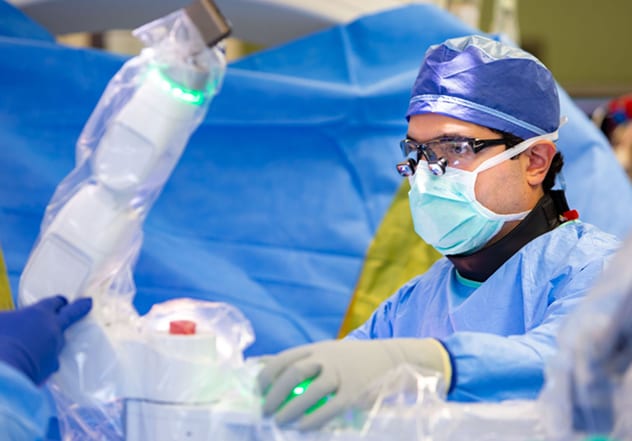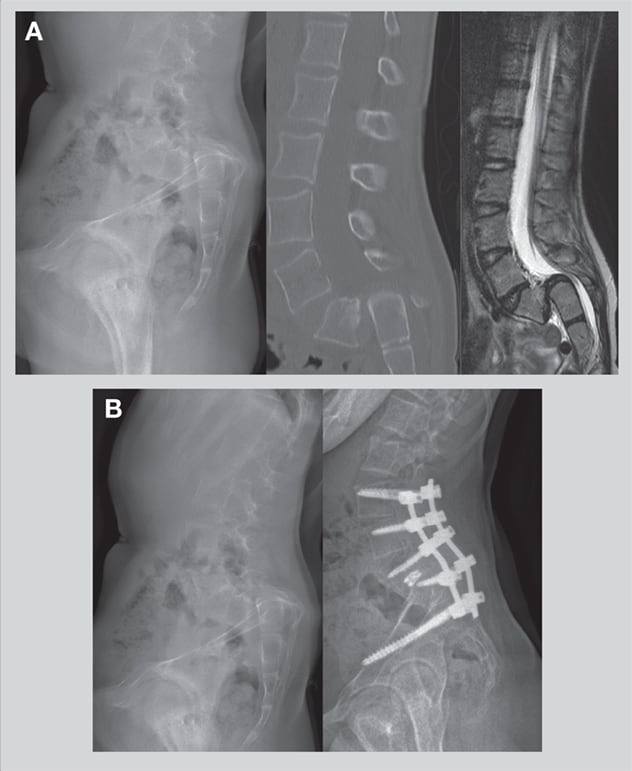Sept. 05, 2019
جراحة العمود الفقري باستخدام تقنية جديدة موجهة بالروبوت

جراحة العمود الفقري باستخدام تقنية جديدة موجهة بالروبوت
يرأس محمد بيدون، دكتور في الطب، وجراح الأعصاب في Mayo Clinic في مدينة روتشستر، ولاية مينيسوتا، فريقًا معنيًّا بإجراء جراحة العمود الفقري باستخدام تقنية جديدة موجهة بالروبوت.
Mayo Clinic in Rochester, Minnesota, was the first center in the upper Midwest to perform spinal surgery using the latest robot-guided technology. The system, which incorporates advanced software to enhance surgical precision, is also available at Mayo Clinic's campuses in Arizona and Florida.
"Our team at Mayo Clinic has performed more than 20 spinal robotic surgeries since acquiring the system in fall 2018, with positive results thus far," says Mohamad Bydon, M.D., a neurosurgeon at Mayo Clinic's campus in Minnesota. "Even at this early stage, it is clear that robotic technology can make spinal surgeries safer and more efficient, and result in better outcomes."
Mayo Clinic spent almost two years studying various systems before committing to the new technology, which is currently used for surgery in the thoracic and lumbar spine.
The basis of robotic spine surgery is navigational software that was partly developed at Mayo Clinic. Mayo is collecting data from its use of the new system to further develop the technology, in conjunction with the manufacturer.
"Having a robust database from all three of our campuses will allow us to help advance this technology," says Selby G. Chen, M.D., a neurosurgeon at Mayo Clinic in Jacksonville, Florida.
Accuracy, efficiency and safety
إدخال جهاز في العمود الفقري أثناء إجراء دمج دعامة صغيرة بين ثقب الفقرة القطنية الرابعة والفقرة العجزية الأولى

إدخال جهاز في العمود الفقري أثناء إجراء دمج دعامة صغيرة بين ثقب الفقرة القطنية الرابعة والفقرة العجزية الأولى
تُظهر الأشعة السينية بعد العملية إدخال جهاز في العمود الفقري أثناء إجراء جراحة طفيفة التوغل بمساعدة الروبوت عند الفقرة القطنية الرابعة والفقرة العجزية الأولى، وذلك بدمج دعامة صغيرة بين ثقب الفقرات القطنية، وقد أُجريت العملية في مركز Mayo Clinic بجاكسونفيل، ولاية فلوريدا. كان المريض رجلًا في الرابعة والسبعين من عمره خضع سابقًا لثقب الفقرات القطنية الرابعة والخامسة في الناحية اليمنى، بسبب ضعف شديد في الطرف السفلي الأيمن دون تحقيق فائدة كبيرة. وقد حسَّن الدمج طفيف التوغل من قوة ساقه إلى حد كبير.
The new system's major benefit is greater precision in the placement of hardware during spinal surgery. CT or fluoroscopic imaging before and during surgery help determine the path used by the robot at every level of the spine.
"The system's software guides the robotic arm into position during surgery. In that way the surgical plan is translated to trajectory guidance in the surgical field," Dr. Bydon says. "The accuracy achieved with the system has been excellent. In addition, the disruption to tissue has been less than we would normally see. We've noted that patients have less postoperative pain, lower use of pain medication and shorter hospitalization."
One of the first patients to undergo surgery with the new system had spinal instability and spondylolisthesis in addition to severe spinal stenosis. He underwent successful robotic surgery and has experienced an excellent outcome to date.
المسار التوجيهي في المجال الجراحي

المسار التوجيهي في المجال الجراحي
يترجم برنامج متطور الخطة الجراحية إلى مسار توجيهي في المجال الجراحي.
Advanced software distinguishes the new system from previous technology. Mayo Clinic's data will be used to refine the software and further improve the system.
"Currently, the robot's primary utility is with the placement of spinal instrumentation. But as the software becomes more sophisticated, I imagine the robot will be able to assist us in other parts of the surgery, including bone work, disk preparation and potentially even deformity correction," Dr. Chen says.
"Software has the ability to change how we do surgeries in the future," Dr. Bydon adds. "Our team at Mayo Clinic is at the forefront of that effort. Bringing robotic technology into the operating room can make spinal surgery safer and more reproducible, to benefit more patients."
The Patient Experience at Mayo Clinic
All three Mayo Clinic campuses use the latest robot-guided technology for thoracic and lumbar spinal surgery, when appropriate. Learn more about what patients experience with robot-guided spinal surgery at Mayo Clinic.
For more information
Robotic-assisted spinal surgery improves outcomes. Mayo Clinic.